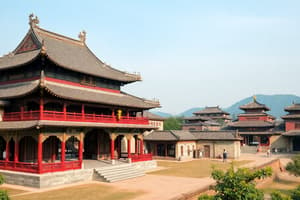Podcast
Questions and Answers
What was the primary purpose of the Great Wall of China?
What was the primary purpose of the Great Wall of China?
- To serve as a trade route
- To connect various Chinese cities
- To protect China from invasions (correct)
- To provide shelter for travelers
Which city in China is known for its historical landmarks such as the Great Wall and the Forbidden City?
Which city in China is known for its historical landmarks such as the Great Wall and the Forbidden City?
- Chengdu
- Shanghai
- Beijing (correct)
- Guangzhou
Which philosopher's teachings form the foundation of Confucianism?
Which philosopher's teachings form the foundation of Confucianism?
- Zhuangzi
- Confucius (correct)
- Lao Tzu
- Siddharta Gautama
What is the primary language spoken by the majority of people in China?
What is the primary language spoken by the majority of people in China?
Why is the Forbidden City named as such?
Why is the Forbidden City named as such?
Which city is regarded as a technological manufacturing center and is located adjacent to Hong Kong?
Which city is regarded as a technological manufacturing center and is located adjacent to Hong Kong?
What does Taoism emphasize as part of its doctrines?
What does Taoism emphasize as part of its doctrines?
Which ancient city is famous for the Terracotta Army and was a starting point of the Silk Road?
Which ancient city is famous for the Terracotta Army and was a starting point of the Silk Road?
During which dynasty was the Great Wall of China primarily built?
During which dynasty was the Great Wall of China primarily built?
Over 2000 years ago, which religion was introduced to China from India?
Over 2000 years ago, which religion was introduced to China from India?
Flashcards are hidden until you start studying
Study Notes
Ancient Civilization and Culture
- China is one of the four ancient civilizations with a history spanning over 5,000 years.
- Chinese culture is characterized by diverse traditions, festivals, and beliefs that are still practiced today.
The Chinese People
- The Chinese are the largest ethnic group globally.
- Mandarin is the most widely spoken language, although various dialects exist across the country.
Major Cities
- Beijing: Capital known for the Great Wall, Forbidden City, and Tiananmen Square.
- Shanghai: Largest city and global financial hub, featuring the Oriental Pearl Tower and Bund waterfront.
- Guangzhou: Major port city renowned for trade markets and Cantonese cuisine.
- Shenzhen: Tech hub known for innovation and as a global technology manufacturing center.
- Chengdu: Famous for spicy cuisine and giant pandas.
- Xi'an: Known for the Terracotta Army and as the starting point of the Silk Road.
- Chongqing: Major city known for its hilly terrain and hot pot cuisine.
- Wuhan: Central city on the Yangtze known for universities and historical significance.
- Hangzhou: Famous for West Lake and its role in tech and e-commerce.
- Nanjing: Historically significant city, once a capital of several dynasties.
Religions in China
- Buddhism: Originated over 2,000 years ago from India, teachings based on Siddhartha Gautama (Buddha).
- Confucianism: Founded by Confucius, focusing on moral, social, and political philosophy.
- Taoism: Established by Lao Tzu about 1,700 years ago, emphasizing doctrines of humility, calmness, and patience.
Significant Landmarks
- Great Wall of China: Iconic structure built over several dynasties, primarily during the Ming Dynasty for protection against invasions. A UNESCO World Heritage Site.
- Forbidden City: Largest palace complex globally, encompassing over 980 buildings, served as the emperor's ceremonial center from the Ming to Qing Dynasties.
- Terracotta Warriors: Life-sized clay figures buried near the tomb of Qin Shi Huang, discovered in 1974, reflecting the military power of the Qin Dynasty.
- Potala Palace: Symbol of Tibetan Buddhism, built in the 17th century at a high altitude, serving as the historical seat of the Dalai Lamas.
Language Diversity
- Mandarin: Official language, spoken by over 1 billion people.
- Cantonese: Around 60-70 million speakers, prominent in Hong Kong culture.
- Shanghainese: Approximately 80 million speakers, known for tonal complexity.
- Hokkien: Spoken by 30-40 million, prevalent in Fujian and Taiwan.
- Hakka: Around 30-45 million speakers, reflecting a distinct cultural identity.
- Gan: About 20 million speakers, primarily in Jiangxi Province.
- Xiang: Approximately 36 million speakers, spoken in Hunan Province.
- Tibetan: Around 6 million speakers, in the Tibet Autonomous Region.
- Uyghur: Approximately 10-12 million speakers, predominant in Xinjiang.
- Mongolian: Around 6 million speakers, mainly in Inner Mongolia.
- Zhuang: Approximately 16-18 million speakers, spoken by the Zhuang ethnic group.
- Manchu: Very few fluent speakers left, historically significant during the Qing Dynasty.
- Korean: Spoken by around 2 million in northeastern provinces.
- Dai: About 1.2 million speakers in Yunnan Province, bordering Southeast Asia.
Studying That Suits You
Use AI to generate personalized quizzes and flashcards to suit your learning preferences.




